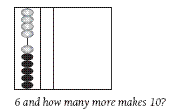This is a level 2 number activity from the Figure It Out series. It relates to Stage 5 of the Number Framework.
A PDF of the student activity is included.
Click on the image to enlarge it. Click again to close. Download PDF (360 KB)
use compatible numbers to solve addition problems
Number Framework Links
Use these activities to:
• encourage transition from advanced counting strategies (stage 4) to early additive strategies (stage 5)
• help the students who are beginning to use early additive strategies (stage 5) to become confident at this stage
• help your students to consolidate and apply their knowledge of groupings with 20, 50, and 100 (place value, stage 4).
FIO, Levels 2-3, Number Sense and Algebraic Thinking, Book One, Wrapping Up Wontons, page 1
A bead frame (optional)
Activity One
This activity encourages students to use compatible numbers to make groups of 20 and 50. With a guided teaching group, talk through the context and encourage the students to look for the key information. Check that they know what a wonton wrap is. Before the students move to making groups of 20 and 50, revise counting in 5s and 10s and addition facts to 20 (or to 10 first, if some students need that practice). Use the bead frame as a focus for some quick recall questions and skip-counting practice.
Encourage the students to move beyond materials to imaging piles larger than 10. You could ask them to image the extra wrappers (beads) on the piles as well as image the number and the action needed to make the pile of 20 or 50.
Activity Two
In this activity, the students solve addition and subtraction problems with a sum of 100. Likely compatible number strategies include attending to the tens that make 90 and then looking at the ones.
Make sure the students understand the change in context to a platter of food. A bead frame laid flat or a small hundreds board could be used to model a platter holding 100 items.
Avoid instructing the students in ways that lead them to simply memorise a set of actions. Working in groups will give the students the opportunity to “buy into” a strategy or choose to improve their thinking.
To encourage imaging, use an unnumbered hundreds board and mark only the position that shows the number of food items. For example, a counter on the 55 position shows how many items are left. The students could then image the amount needed to fill the board.
To reinforce the use of number properties, the students could use numbers and diagrams to record the oral language they use to explain their strategy. For example, for question 2a i:
If you want to use these activities with independent groups, put the students in problem-solving groups of 3–4 students and have them discuss what each problem is about before they attempt some solutions. Encourage the groups to check that their solutions answer the questions.
Mixed-ability groups work well if the whole team has to be able to explain their solution strategies rather than leaving the best mathematician in the group to report back. Afterwards, have the groups come together to share their strategies and solutions. This will provide an environment for the students to see and hear a range of strategies and will generate an opportunity for those who are advanced counters to “buy into” a part–whole strategy.
You can help the students to clarify and reflect on each other’s strategies and encourage part–whole thinking with interactions such as:
So you started at 27, then counted in tens to 97, then counted on 3 more. This helped you to see that you needed 70 and 3, which was a total of 73.
Did anyone work it out without having to do any counting?
Answers to Activities
Activity One
1. Add piles a and e: 8 + 12 = 20
Add piles b and f: 6 + 14 = 20
Add piles c and d: 13 + 7 = 20
2. a. 23. (27 + 23 = 50)
b. 31. (19 + 31 = 50)
c. 12. (38 + 12 = 50)
d. 44. (6 + 44 = 50)
e. 29. (21 + 29 = 50)
Activity Two
1. Methods will vary. She could use a double
number line:
On this number line, An-Mei finds 55 on the top and works out that the complement on the bottom must be 45.
Another method is: 55 + 5 = 60 and 60 + 40 = 100, so An-Mei needs
5 + 40 = 45 items.
2. a. i. 36. (The double number line of complements to 100 shows 64 on top
and 36 below:
Or: 64 + 6 = 70 and 70 + 30 = 100, so 6 + 30 = 36 items are needed.)
ii. 27. (73 – 3 = 70 and 70 + 30 = 100, so 30 – 3 = 27 items are needed.)
iii. 11. (89 + 1 = 90 and 90 + 10 = 100, so 1 + 10 = 11 items are needed.)
b. i. 68. (32 – 2 = 30 and 30 + 70 = 100, so 70 – 2 = 68 items were on the platter.)
ii. 59. (41 – 1 = 40 and 40 + 60 = 100, so 60 – 1 = 59 items were on the platter.)
iii. 63. (37 + 3 = 40 and 40 + 60 = 100, so 60 + 3 = 63 items were on the platter.)
3. Problems will vary.




